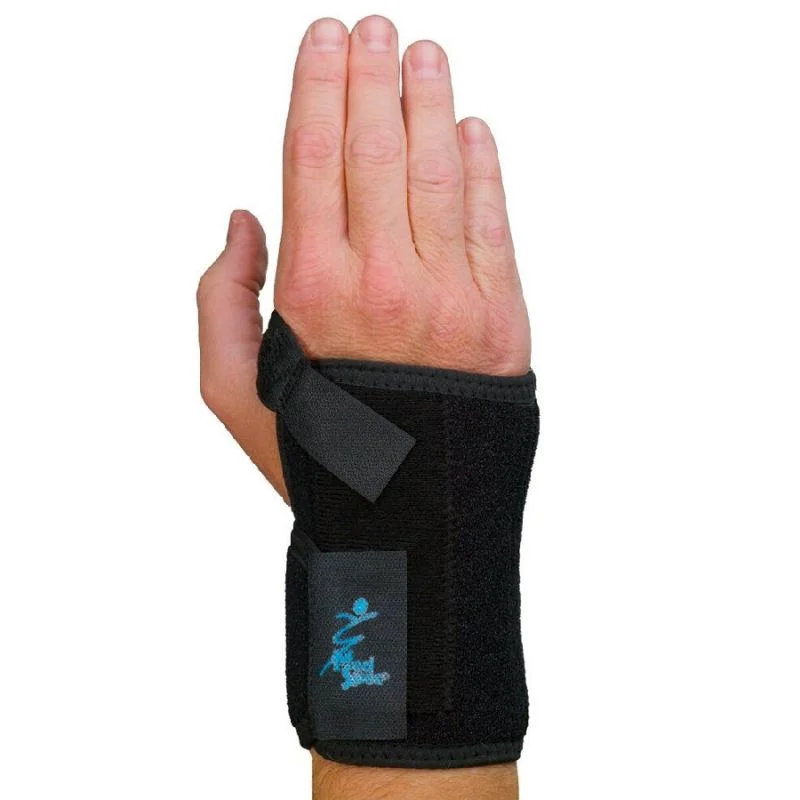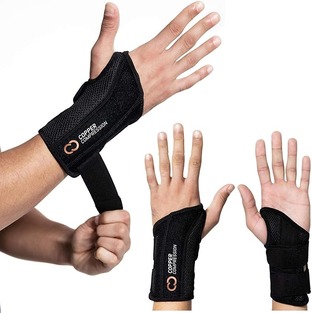The following article discusses tendonitis that involves the swelling in the tendons of the wrist; it could be developed through repetitive use, overuse, and injury of the wrist.
We’ll also review five wrist braces designed to support tendonitis. These braces have various cool stuff, like comfortable shapes and adjustable tightness, to help soothe your wrist. They’re designed to offer you the support you need to feel good again.
BEST WRIST BRACE FOR TENDONITIS
1. DonJoy Wrist Wraps Support Brace
Donjoy wrist brace design helps to limit specific moves, in the direction of bending or stretching, or on the side of moving the wrist. Great for all those situations where you need to have your repetitive motion in check.
It is versatile, works fine in many things-from sports to jobs requiring so much hand and wrist movements it will be useful in different situations. This brace will come with replaceable foam inserts, allowing you to adjust the support level to the needed one. The rotating brace creates an airtight seal while straps on the brace stop it from rotating, making it better at keeping your wrist stable and relieve pain.
For your comfort, the DonJoy Wrist Wraps Support Brace has a soft neoprene lining on its interior. It feels nice against your skin. The outer shell is fabricated from durable woven nylon-so it can withstand extensive use.
2. Med Spec Ryno Lacer Wrist Support
Introducing the Med Spec Ryno Lacer Wrist Support-easy to use with a simple lace closure. It features stays on either side and in the back of the wrist for stability, limiting movement of the thumb.
The Ryno Lacer is lined with polypropylene and breathable suede to get the sweat evaporated, hence keeping your skin very comfy and cool. Sleek in design, not bulky, comfortable to wear-and thus will be worn regularly.
This wrist support is proudly made in the USA, built to high standards of quality that entail better control. Med Spec Ryno Lacer combines practicality, comfort, and quality craftsmanship into a premium wrist support.
3. Copper Compression Wrist Brace
Copper Compression Wrist Brace is designed to give critical tendonitis support to strained muscles, inflame tendons, and joints of your wrist and hand. It relieves at rest to improve mobility in the affected areas. It is good for conditions like a sprained wrist, arthritis, Carpal Tunnel Syndrome, and many more for day and night use.
Secure it with the hook-and-eye straps. The top hook-and-eye strap should, if possible, be higher up toward your hand or wrist, and the bottom one lower down on your forearm. A brace is easier to maneuver in compared to a cast and is used to treat conditions like tendonitis.
Construction is by copper-infused nylon; hence, this tendonitis brace is hygienic even beyond a lot of washing. The copper does not wash out, making it very effective for a long period. Material construction allows for moisture to escape and keeps you dry in all your activities. It’s tough against wash, remaining reliable for extended use.
4. WristWidget® Black Adjustable Wrist Brace
This is a versatile product for use on either wrist and suits a wide range of sizes, from 14 to 22cm. It’s perfect to wear while engaging in any sporting activity and can be worn in the water without inhibiting movement. It can be used by both highly active or casual day-to-day persons with strong support throughout the day and into the night.
The WristWidget® is designed to support both the Radius and Ulna and aids in healing the TFCC (Triangular Fibrocartilage Complex) without surgery. It relieves ulnar-sided wrist pain associated with rotational, gripping, and weight-bearing activities.
Proudly manufactured in Hawaii, USA, in a factory that is solar-powered and zero-waste, it reflects a concern for the environment. With a lifetime guarantee, it’s latex and rubber-free, DEHP-free, MRI safe, and reusable.
5. ComfyBrace Night Wrist Sleep Support Brace
The adjustable ComfyBrace fits for both men and women, and fits seamlessly on either hand. No more loose yet stifling braces. This cutting-edge 2024 model offers extreme support, maximum comfort, durability, and versatility. Its slip-on sleeve design makes it quick, thus eliminating frustration when trying to secure your wrist.
Combat wrist pain now with the support of a splint and soft compression with our professionally designed brace, featuring a removable palmar splint, well-placed straps, and plush-beaded cushion for Carpal Tunnel Syndrome, Arthritis, Tendonitis, and post-cast discomfort. Super breathable materials allow for comfortable wearing day and night.
Indulge in plush, therapeutic bead-cushion support that molds to the shape of your hand for ultimate soothing comfort. Secure the brace with expertly designed straps for therapeutic relief and breathability.
WHAT TO CONSIDER WHEN BUYING WRIST BRACE FOR TENDONITIS?

- Type of Tendonitis
Determine your specific type of wrist tendonitis, as different braces will provide different types of support depending on which tendons are affected.
2. Fit and Size
The fit should not be too tight while still being comfortable. This may vary in size between brands, so refer to the sizing of the specific manufacturer to make sure the support is good without added pressure.
3. Adjustability
Opt for a brace featuring adjustable straps or closures. This allows for more personalized compression and support for comfort and the degree of tendonitis.
4. Material and Breathability
Look for a brace made from breathable, moisture-wicking materials that prevent excessive perspiration and discomfort during longer use.
5. Supporting Structure
Think of design and construction of the brace. Some include metal or plastic splints for additional stability, while others are more flexible. The level of support provided will, of course depend on the severity of your tendonitis.
FAQ
A wrist brace provides support and immobilization to the affected wrist, reducing strain on inflamed tendons. This helps alleviate pain, promotes healing, and prevents further aggravation during daily activities.
The duration of wrist brace usage depends on the severity of the tendonitis and the advice of your healthcare provider. Generally, braces are worn during activities that might strain the wrist and during rest periods to aid the healing process. Your healthcare provider will guide you on the appropriate duration and usage based on your specific condition and needs.
Yes, wearing a wrist brace at night can be beneficial, particularly if you’re dealing with nighttime pain or discomfort. Using a brace during the night helps keep your wrist in a neutral position, preventing uncomfortable postures that could worsen symptoms while you sleep. This can contribute to a more restful and comfortable night’s sleep.
Seek advice from a healthcare professional or a physical therapist for personalized exercises and stretches. They can offer specific guidance on maintaining wrist flexibility and strength without jeopardizing the healing process or worsening tendonitis. Individualized recommendations will help ensure that your exercises are safe and beneficial for your unique situation.
Absolutely, wearing wrist braces during different activities is common. However, it’s crucial to adhere to your healthcare provider’s advice. If recommended, take breaks to perform prescribed exercises and, when appropriate, remove the brace. Your healthcare professional might also suggest ergonomic changes to daily activities to minimize strain on the wrist. It’s important to follow their guidance for an effective and safe recovery.






